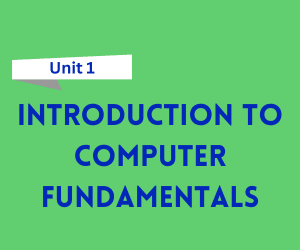
Free Download Introduction to Computer Fundamentals Notes in pdf – Bca 1st Semester. High quality, well-structured and Standard Notes that are easy to remember.
Click on the Download Button 👇
Introduction to Computer Fundamentals
Computer Fundamentals is the study of the basic concepts, technologies, and components that make up a computer system. It provides a solid foundation for understanding how computers work, their functionality, and their applications in various domains such as business, education, science, and entertainment. The subject covers hardware, software, data representation, and the principles of computing.
Key Components of a Computer System
A computer system is composed of several essential components that work together to process data and generate output. These components are broadly classified into hardware and software:
Hardware:
- Input Devices: Devices used to enter data into a computer (e.g., keyboard, mouse, scanner).
- Output Devices: Devices used to convey information from a computer to the user (e.g., monitor, printer, speakers).
- Central Processing Unit (CPU): The brain of the computer responsible for executing instructions, composed of:
- Control Unit (CU): Directs the operation of the processor.
- Arithmetic Logic Unit (ALU): Performs arithmetic and logic operations.
- Memory: Stores data and instructions for processing. It is divided into:
- Primary Memory (RAM, ROM): Temporary storage (RAM) and permanent storage (ROM).
- Secondary Memory (Hard Drives, SSDs): Permanent storage used for storing data long-term.
- Storage Devices: Devices that store data, including magnetic storage (hard drives), optical storage (CDs, DVDs), and solid-state storage (SSDs, USB drives).
Software:
- System Software: Programs that control the operation of the hardware. It includes:
- Operating System (OS): Software that manages hardware and provides services for application software (e.g., Windows, macOS, Linux).
- Utility Software: Tools for system maintenance (e.g., antivirus, disk cleanup).
- Application Software: Programs designed to perform specific tasks (e.g., word processors, spreadsheets, web browsers).
- Programming Software: Tools used to write, test, and maintain software programs (e.g., compilers, text editors).
- System Software: Programs that control the operation of the hardware. It includes:
Data Representation:
- Binary System: Computers use binary (0s and 1s) to represent all forms of data.
- Number Systems: Understanding of binary, decimal, octal, and hexadecimal number systems.
- Data Units: Measurement units of data such as bits, bytes, kilobytes, megabytes, gigabytes, etc.
Types of Computers
Computers can be classified based on various factors such as size, purpose, and technology:
Based on Purpose:
- General-Purpose Computers: Designed to perform a wide variety of tasks (e.g., personal computers, laptops).
- Special-Purpose Computers: Designed for specific tasks (e.g., ATMs, embedded systems).
Based on Size and Power:
- Supercomputers: The most powerful computers used for complex calculations in fields like climate modeling, scientific research, and nuclear simulations.
- Mainframe Computers: Large and powerful systems used by organizations for large-scale processing of data, such as in banking and healthcare.
- Minicomputers: Mid-range computers that were once common but are now largely replaced by powerful servers.
- Microcomputers (Personal Computers): Desktop computers, laptops, tablets, and smartphones designed for individual use.
Based on Technology:
- Analog Computers: Process continuous data (e.g., thermometers, speedometers).
- Digital Computers: Process discrete data (binary) and are most common today (e.g., desktops, laptops).
- Hybrid Computers: Combine the features of both analog and digital computers (e.g., devices in medical equipment).